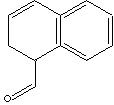PRODUCT IDENTIFICATION

EINECS NO.
CLASSIFICATION
PHYSICAL AND CHEMICAL PROPERTIES
1.15
APPLICATIONS
APPEARANCE
98.0% min
MELTING POINT
|
|
|
| 1-NAPHTHALDEHYDE | ||
|
PRODUCT IDENTIFICATION |
||
| CAS NO. | 66-77-3 |
|
|
EINECS NO. |
200-633-4 | |
| FORMULA | C11H8O | |
| MOL WT. | 156.18 | |
| H.S. CODE | ||
| TOXICITY | Oral, Rat LD50 : 667 mg/kg | |
| SYNONYMS | 1-Naphthalenecarboxaldehyde; 1-Formylnaphthalene; | |
| RAW MATERIALS |
|
|
|
CLASSIFICATION |
|
|
|
PHYSICAL AND CHEMICAL PROPERTIES |
||
| PHYSICAL STATE | light yellow liquid | |
| MELTING POINT | 1 - 2 C | |
| BOILING POINT | 160 - 161 C | |
| SPECIFIC GRAVITY |
1.15 |
|
| SOLUBILITY IN WATER | 1 g/l at 20 C | |
| pH | ||
| VAPOR DENSITY) | ||
| FLASH POINT | 112 C | |
|
APPLICATIONS |
||
| Compounds which do not have alpha-hydrogen atoms cannot form an enolate ion and do not undergo electrophilic alpha-substitution and aldol condensation. Aromatic aldehydes such as benzaldehyde and alpha-naphthaldehyde and formaldehyde may undergo disproportionation in concentrated alkali (Cannizaro's reaction); one molecule of the aldehyde is reduced to the corresponding alcohol and another molecule is simultaneously oxidized to the salt of a carboxylic acid. The speed of the reaction depends on the substituents in the aromatic ring. Two different types of aldehydes (aromatic and aliphatic) can undergo crossing reaction to form fomaldehyde and aromatic alcohols. | ||
| SALES SPECIFICATION | ||
|
APPEARANCE |
Clear to yellowish liquid | |
| ASSAY |
98.0% min |
|
|
MELTING POINT |
1 - 2 C | |
| TRANSPORTATION | ||
| PACKING | 200kgs in Drum | |
| HAZARD CLASS | TSCA Listed | |
| UN NO. | ||
| REMARKS | ||
|
|
||
|
|
|